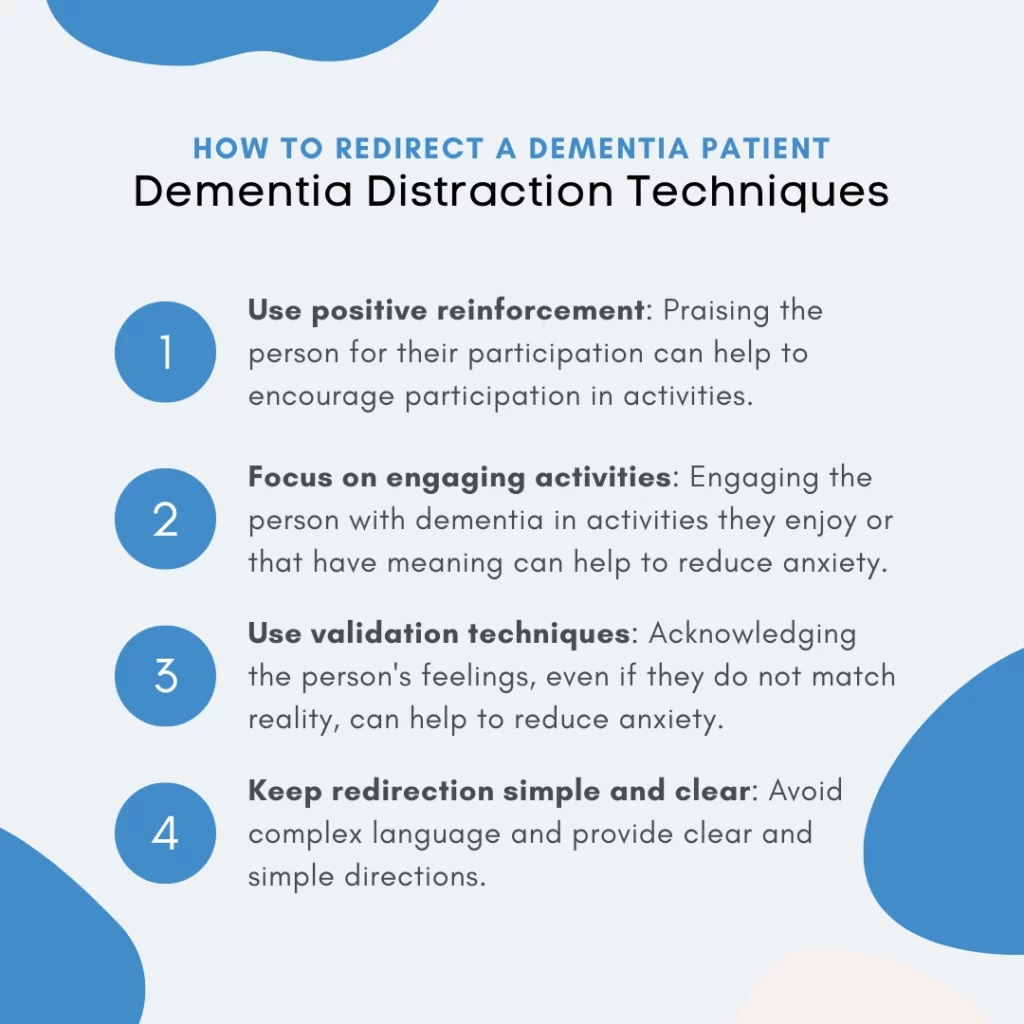
Dementia Distraction Techniques – How to Help People with Dementia
This post may contain affiliate links or Google Ads and we may earn a small commission when you click on the links at no additional cost to you. As an Amazon Affiliate, we earn from qualifying purchases. This is at no additional cost to you and helps with our website expenses.
Distraction and redirection techniques effectively engage individuals with dementia in positive and stimulating activities or redirect their attention away from distressing thoughts or situations.
Distraction techniques can include activities such as music therapy, art therapy, or sensory stimulation. On the other hand, redirection techniques might involve reminiscence therapy, validation therapy, or redirecting a conversation.
In this blog post, we will discuss the different types of dementia distraction techniques that can be used to help manage symptoms and improve the quality of life for people with dementia.
We will also provide practical tips and strategies for their implementation and discuss the importance of remaining patient and calm when caring for someone with dementia.
Dementia Distraction Techniques
Distraction techniques are a valuable tool for managing the symptoms of dementia. These techniques work by engaging the person with dementia in positive and stimulating activities, which can help to reduce anxiety, agitation, or other symptoms.
Distraction Techniques and How They Work
Distraction techniques are designed to redirect the attention of a person with dementia away from distressing thoughts or situations. By engaging the person in positive and stimulating activities, caregivers and loved ones can help to improve their overall well-being.
Distraction techniques work by stimulating different parts of the brain, such as memory or emotion centers, and can help to alleviate symptoms such as anxiety, depression, or confusion.
Examples of Distraction Techniques for Dementia Patients
There are several different distraction techniques that can be used to manage symptoms and improve the quality of life for people with dementia. Some examples include:
- Music therapy: playing familiar music or songs that have a special meaning to the person with dementia can help to evoke memories, improve mood, and promote a sense of well-being.
- Art therapy: engaging in creative activities such as painting, drawing, or sculpting can help to promote self-expression, reduce anxiety, and provide a sense of accomplishment.
- Sensory stimulation: using scents, textures, or colors to engage the senses can help to promote relaxation, improve cognitive function, and reduce agitation.
Case Studies or Anecdotes Illustrating the Effectiveness of Dementia Distraction Techniques
There are many examples of how distraction techniques can be used in practice. Here are a few:
- A study published in the Journal of Gerontological Nursing found that music therapy helped to reduce agitation and improve sleep quality in individuals with dementia.
- Another study published in the American Journal of Alzheimer’s Disease and Other Dementias found that sensory stimulation helped to reduce anxiety and improve cognitive function in individuals with dementia.
Sources:
- Brotons, M., & Koger, S. M. (2000). The impact of music therapy on language functioning in dementia. Journal of Music Therapy, 37(3), 183-195.
- Garland, K., Beer, E., Eppingstall, B., & O’Connor, D. W. (2007). A comparison of two treatments of agitated behavior in nursing home residents with dementia: simulated family presence and preferred music. The American Journal of Geriatric Psychiatry, 15(6), 514-521.
- Lai, C. K., Chi, I., & Kayser-Jones, J. (2004). A randomized controlled trial of a specific reminiscence approach to promote the well-being of nursing home residents with dementia. International Psychogeriatrics, 16(1), 33-49.
An Anecdote about using Dementia Distraction Techniques to help a Grandmother with Dementia
“When my grandmother was diagnosed with dementia, I quickly realized how challenging her care could be. One particularly difficult situation happened when she went through a period of feeling overwhelmed and anxious.
To help her cope, I started using distraction techniques – like sharing funny stories or taking a walk together in the garden. It worked wonders! My grandmother’s mood shifted back to normal and she was able to relax.
Distraction may not always work, but it’s certainly worth trying – especially when you’re dealing with dementia-related struggles.”
Overall, distraction techniques can be an effective way to help manage symptoms and improve the quality of life for people with dementia. By engaging the person with dementia in positive and stimulating activities, caregivers and loved ones can help to reduce anxiety, improve mood, and promote a sense of well-being.
Tactile Objects and Activities to Use for Distraction Techniques for Dementia Patients
Distraction is often a great way to help people with dementia when they are feeling overwhelmed or anxious. Fidget blankets, puzzles, music, art activities, and other tactile objects can help redirect their energy.
Other activities like talking about their favorite memories, sharing stories, playing board games, and taking walks in the park can also be helpful in distracting them from their anxious feelings.
Here’s a list of some creative distraction items and activities that may help:
- Fidget blankets
- Tactile objects (e.g., picture books)
- Puzzles & problem-solving tasks
- Music & sound therapy
- Art activities
- Sharing stories & memories
- Board games
- Taking walks in the park
Redirection Techniques for Dementia
Redirection techniques are another useful tool for managing the symptoms of dementia. These techniques involve redirecting the attention of a person with dementia to a different topic or activity in order to reduce stress or agitation.
Redirection techniques work by providing a sense of purpose or engagement for the person with dementia and can help to alleviate symptoms such as confusion, anxiety, or depression.
How They Work
Redirection techniques involve gently redirecting the attention of a person with dementia away from distressing thoughts or situations. This can involve offering a different topic of conversation, engaging in a new activity, or simply changing the subject.
By providing a sense of purpose or engagement, redirection techniques can help to reduce anxiety, improve mood, and promote a sense of well-being.
Examples of Redirection Techniques for Dementia Patients
There are several different redirection techniques that can be used to manage symptoms and improve quality of life for people with dementia. Some examples include:
- Reminiscence therapy: encouraging the person with dementia to talk about past experiences or memories can help to promote a sense of connectedness and well-being.
- Validation therapy: acknowledging the person’s feelings and experiences, even if they do not match reality, can help to reduce anxiety and improve communication.
- Redirecting conversation: changing the topic of conversation or offering a distraction can help to redirect the person’s attention away from distressing thoughts or situations.
Sources
- Brooker, D., & Latham, I. (2016). Person-centered Dementia Care: Making Services Better with the VIPS Framework (2nd ed.). Jessica Kingsley Publishers.
Redirection techniques can be an effective way to help manage symptoms and improve the quality of life for people with dementia. By redirecting the person’s attention to more positive and engaging topics or activities, caregivers and loved ones can help to reduce anxiety, improve mood, and promote a sense of well-being.
Distraction and Redirection in Practice
Distraction and redirection techniques can be effective ways to manage symptoms. It can improve the quality of life for people with dementia. However, implementing these techniques in practice can present certain challenges.
In this section, we will discuss how to determine which technique is appropriate for a given situation or individual. We will address common challenges in using distraction and redirection techniques. Also, we will provide tips and strategies for incorporating these techniques into daily caregiving routines.
How to Determine Which Technique is Appropriate
When deciding which distraction or redirection technique to use, it is important to consider the individual needs and preferences of the person with dementia. Here are some factors to consider:
- Cognitive and functional abilities: Consider the person’s level of cognitive and functional abilities when selecting activities or topics of conversation.
- Personal preferences: Consider the person’s personal preferences and interests when selecting activities or topics of conversation.
- Level of engagement: Monitor the person’s level of engagement and adjust activities or topics of conversation as needed to maintain interest.
Addressing Common Challenges
There are several common challenges that caregivers and loved ones may face when using distraction and redirection techniques. Some of these challenges include:
- Caregiver burnout: Providing care for a person with dementia can be emotionally and physically demanding, leading to caregiver burnout. It is important for caregivers to take breaks and seek support when needed.
- Resistance from the person with dementia: Some people with dementia may be resistant to distraction or redirection techniques, which can make them challenging to implement. It is important to remain patient and persistent and to adjust techniques as needed to suit the individual’s needs.
Tips and Strategies
Here are some tips and strategies for incorporating distraction and redirection techniques into daily caregiving routines:
- Plan ahead: Have a plan in place for using distraction and redirection techniques, and be prepared to adjust the plan as needed based on the person’s needs and preferences.
- Be patient and flexible: Distraction and redirection techniques may not always work the first time, so be patient and flexible in your approach.
- Use positive reinforcement: Praise and positive reinforcement can be effective ways to encourage engagement and participation.
- Get support: Seek support from family, friends, or professional caregivers to help alleviate the burden of providing care.
By incorporating distraction and redirection techniques into daily caregiving routines, caregivers and loved ones can help to manage symptoms and improve the quality of life for people with dementia.
It is important to consider the individual needs and preferences of the person with dementia, address common challenges, and use practical tips and strategies to implement these techniques effectively.
How to Redirect a Dementia Patient
Redirection techniques can be a useful tool for managing symptoms and improving the quality of life for people with dementia. However, caregivers and loved ones may find themselves in situations where they need to redirect a person with dementia to prevent or manage symptoms such as agitation, confusion, or wandering.

Common Situations that Require Redirection
There are several common situations where caregivers and loved ones may need to redirect a person with dementia. Some of these situations include:
- Agitation: When a person with dementia becomes agitated, redirecting their attention to a different topic or activity can help to reduce their anxiety and prevent escalation.
- Confusion: When a person with dementia becomes confused or disoriented, redirecting their attention to familiar surroundings or activities can help to reduce their anxiety and improve their sense of well-being.
- Wandering: When a person with dementia wanders, redirecting their attention to engaging activities or familiar routines can help to keep them safe and prevent accidents.
Practical Strategies for Redirection
Here are some practical strategies for redirecting a person with dementia:
- Use positive reinforcement: Praising the person for their participation or engagement can help to encourage continued participation in positive activities.
- Focus on engaging activities: Engage the person with dementia in activities that they enjoy or that have personal meaning to them. This can help to reduce anxiety and promote a sense of well-being.
- Use validation techniques: Acknowledge the person’s feelings and experiences even if they do not match reality. It can help to reduce anxiety and improve communication.
- Keep redirection simple and clear: Avoid using complex language or concepts, and provide clear and simple directions for redirection.

The Importance of Remaining Patient and Calm
When redirecting a person with dementia, it is important to remain patient and calm. People with dementia may become easily confused or frustrated.
It is important to approach redirection with a gentle and compassionate attitude. Avoid becoming agitated or frustrated, and instead focus on remaining calm and supportive.
By using practical strategies for redirection and remaining patient and calm, caregivers and loved ones can help to manage symptoms and improve the quality of life for people with dementia.
With practice and patience, redirection techniques can become an effective tool for promoting well-being and reducing stress for individuals with dementia.
Conclusion of Dementia Distraction Techniques
Dementia can be a challenging condition to manage, but distraction and redirection techniques can be effective tools for managing symptoms and improving the quality of life for people with dementia.
In this article, we have discussed the benefits of distraction and redirection techniques. We have provided examples of these techniques, and outlined strategies for implementing them in daily caregiving routines.
Key takeaways from this article include:
- Distraction and redirection techniques can help to reduce anxiety, improve mood, and promote a sense of well-being for people with dementia.
- Examples of distraction techniques include music therapy, art therapy, and sensory stimulation.
- Examples of redirection techniques include reminiscence therapy, validation therapy, and redirecting conversation.
- Practical strategies for implementing distraction and redirection techniques include planning ahead, using positive reinforcement, and seeking support from others.
- Remaining patient and calm is crucial when implementing distraction and redirection techniques.
In conclusion, by using distraction and redirection techniques in daily caregiving routines, caregivers and loved ones can help to manage symptoms and improve the quality of life for people with dementia.
With patience, persistence, and a compassionate attitude, these techniques can become powerful tools for promoting well-being and reducing stress for individuals with dementia.
